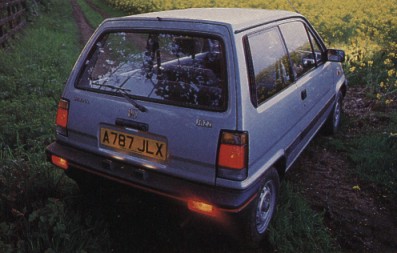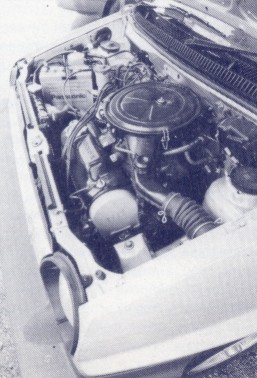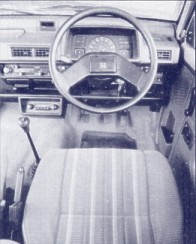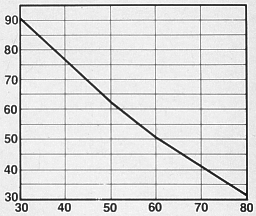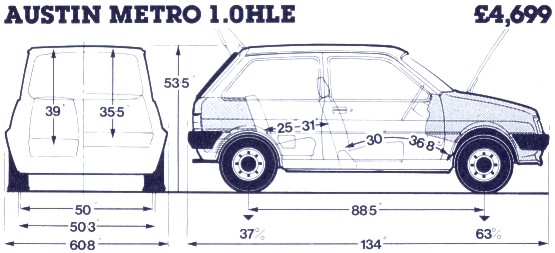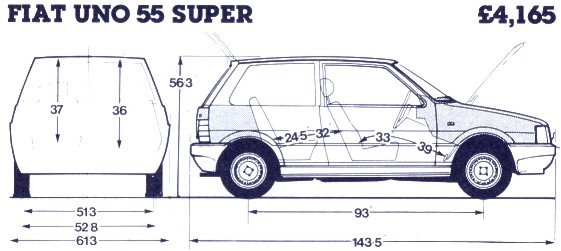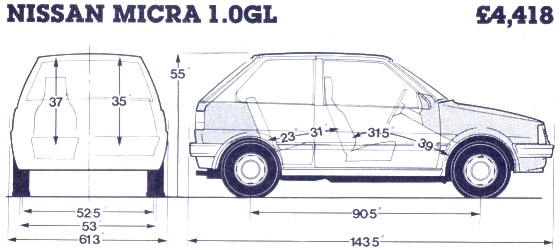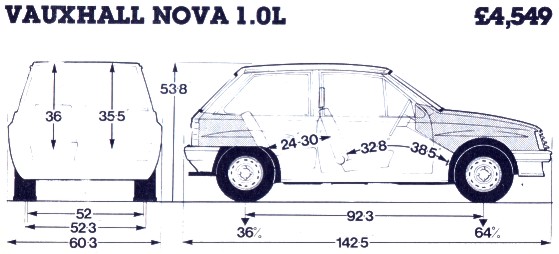

31/84
Testbericht
aus
Motor
week
ending
June 30, 1984
S. 24 - 27
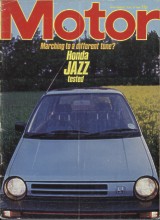
Packaging efficiency is the term widely used in the car industry to express how roomy a car is relative to its outside dimensions. Honda talk in terms of their "inner space" design concept. It means the same thing. The Jazz - called the City in Japan, where it has been produced since 1982 - is shorter than rival supermini cars thanks to the use of a high roof line. The extra headroom available permits a more upright driving position than usual, so that occupants need less fore and aft space than they do with a conventional design. At least that is the theory... Even including the prominent front and rear bumper mouldings, the Jazz's 134 in overall length is an inch shorter than the Austin Metro, yet it is more than an inch taller than the Fiat Uno, and Daihatsu Charade CX High Roof, both notably upright designs. There is nothing inherently new in the tall-town car concept, though, as the Renault 4 and Fiat Panda demonstrate. The Honda is in much the same utilitarian mould as these established designs, but it cannot be considered as a direct competitor to them. Priced at £ 4,315, it will be compared with mid-priced superminis such as the Austin Metro and Fiat Uno. How can Honda justify a premium price for such a small urban runabout? Are they exploiting their reputation for producing well-engineered small cars eminently suited towards Europe? The bold styling will undoubtedly have its detractors but at least it breaks away from the bland uniformity of the crop of Japanese and European superminis. Not only does the body shape fail to conform but the engine has quite a large capacity and consequently healthy power output relative to the size and weight of the Jazz. Producing 56 bhp, the Civic-derived engine is slightly more powerful than the 55 bhp of the similarly priced Nissan Micra 1.0 GL (£ 4,418) and the much cheaper Fiat Uno 55 Super (£ 4,165). Close to these three comes the Daihatsu Charade High Roof (£ 4,679) which produces 51 bhp from its 3-cylinder engine. Some 10 bhp adrift of the Jazz are the Metro 1.0 HLE (£ 4,428) and Vauxhall Nova 1.0 L (£ 4,549). At 13.8 cwt, the Honda is light for this class of car, promising good performance and economy. Honda's first foray into the mini-car scene in the late 1960's - with the diminutive air-cooled N360 and N600 series cars - did not meet with much success in Britain. The Jazz is in many ways a more conservative design. It follows the mechanical layout of the previous generation Civic, sharing a similar all-alloy power unit, five-speed transaxle and all-independent strut-type suspension. However, there are some important differences as it would be uncharacteristic of Honda to produce a totally orthodox design. The engine is a surprisingly long stroke unit, with bore and stroke dimensions of 66 x 90 mm giving a capacity of 1,231 cc. It has a high compression ratio (10.2 : 1) dictating a four star, 97 octane fuel diet. For compactness, the cylinder head is a non-crossflow design and, unlike the current 12-valve Civic engine, has "only" eight valves. As is usual for Honda, a toothed-belt drive is used for the single overhead camshaft, the fuel system uses a twin-venturi carburetter with a manual choke and the ignition system is contactless. The priority was to produce high torque at low engine speeds, rather than high maximum power. Output figures are 56 bhp at 5,000 rpm and 69 lb ft torque at 3,500 rpm. Complementing the torquey engine is a five-speed manual transmission - the Hondamatic auto version is not imported. Fifth gear gives a long-striding 21.8 mph/1,000 rpm, fourth, 18.4 mph/1,000 rpm. It is as well to remember that many rivals - notably the Metro, Samba, Nova and Polo - do not have the luxury of a fifth gear, while it is an extra-cost option on the Fiesta. The Jazz follows the Issigonis-Mini concept of a wheel at each corner; in this case, using 12 in rims shod with 145 section tyres. At the front MacPherson struts are fitted with progressive-rate coil springs while for the rear suspension semi-trailing arms are coil sprung. Despite the tall build (it is not quite as high as it is wide) no anti-roll bars are deemed necessary. Braking is by servo-assisted front discs and rear drums, with the hydraulic circuits spilt diagonally. Rack and pinion steering is used, geared at just over 3.5 turns lock-to-lock. The tall, boxy shape inevitably displaces a lot of air and, with a Cd of 0.40 (actually better than the old Civic) it is significantly less slippery than the best of the bunch, the Uno (0.34). Even so, the maximum speed of 89.1 mph, recorded in fourth gear, is better than most rivals can manage. True, the Fiat Uno's better shape gives it a slight advantage (93.4 mph), but the Austin Metro (85.5 mph), Daihatsu Charade CX (84.6 mph) and Nissan Micra 1.0 GL (87.4 mph) are more typical of the average performance for the class. Gunned through the gears, the Jazz relegates all its rivals to diminishing dots in the rear view mirror. The widely-spaced gear ratios are easily masked by the engine's impressive power characteristics and 60 mph is reached in a very sprightly 12.7 sec - more than a second quicker than the Nissan Micra which is lighter and has a superior power to weight ratio. The Fiat Uno's slippery shape is not much of an asset below 60 mph (it takes 14.2 for the 0 to 60 mph sprint), while rivals like the Austin Metro (18.2 sec) and Vauxhall Nova (18.5 sec) suffer from a considerable power-to-weight ratio disadvantage compared with the Honda. It feels quick too. It is all too easy to provoke an unintentional screech of protest from the tyres, or a burst of wheel-spin in the wet, when moving away from rest. High gearing does not blunt acceleration in the upper gear ratio, as there is more than enough torque to compensate. The 30 to 50 mph fourth gear increment is covered in 10.8 sec, again beating the Fiat Uno (12.7 sec) - the only rival that produces anywhere near as much torque as the Honda. Mechanically sweet and smooth, the Jazz responds very cleanly to the throttle; the only flaw is a second choke hesitancy which abates after a lengthy warm-up period. Audibly it is less than sweet when all the performance is used and the engine noise becomes increasingly loud. Throbby induction growl marks open-road progress, while Mini-like transmission whine predominates around town. But the engine idles impeccably and will spin freely to 6,000 rpm. There is no tachometer, or even gearchange markings on the speedometer, but the handbook suggests maxima of 28, 47 and 68 mph in the lower gears, corresponding to a 5,000 rpm, 500 revs beyond the power peak. The Jazz is a light and flatteringly easy car to drive. The clutch is smooth and progressive, the gearshift - despite a long, spindly lever - as slick and foolproof as one could wish and a well-cushioned drive-line ensures that the car does not jerk, even if the driver is careless. The lightness of the brakes, though, is a disadvantage so far as smoothness is concerned, giving the impression that you really could literally stand this short car on its nose. The raison d'être for many small cars is their low running costs. Many makers list special economy derivatives - such as the Metro HLE, VW Polo Formel E and the Fiat Uno ES - but the Jazz does not appear to need this advantage. Given Motor's usual brisk driving - encouraged by the Honda's eager, cheeky, if somewhat unrefined manner - the overall consumption of 40.8 mpg is particularly creditable. It just pips the Metro HLE's 39.7 mpg, though the latter, and the Nissan Micra 1.0 GL, return better touring consumption figures - showing that they have the potential to give better economy than the Jazz, given restraint. The nine-gallon tank gives a phenomenal 434 miles touring range (for a town car), but the filler flap is sited inconveniently on the car's nearside and does not lock. Some town cars are very adept on the open road. The Jazz is safe and predictable with better stability at speed than one expects, but it does not encourage over-zealous bend-swinging. Firm suspension minimises body roll, but the early onset of tyre squeal followed by strong understeer when you persist inhibits Metro/Nova-style cornering antics. Poor traction when accelerating out of tight corners is another weakness, but there is no tuck-in drama when the throttle is released in mid-bend. Despite the advantage of independent suspension, the Jazz responds in a very lively fashion to uneven roads. It is always firm and clearly gives the impression that suspension travel is minimal and the wheelbase short - prompting one tester to comment that it was reminiscent of a Morris Minor. There is prominent bump-thump over cats'-eyes and a great deal of tyre roar induced over coarse surfaces. Overall, while no worse than a Vauxhall Nova or Suzuki Sa 310 (which have "dead" beam rear axles), the Honda's ride quality is considerably inferior to the best current small car standards exemplified by the Peugeot 205, Fiat Uno and Talbot Samba. Headroom is good, but by no means exceptional. It permits a more upright driving position than usual, encouraged, like the Metro, by an "Italianate" driving position. Compared with the Metro, a good deal more rearward seat travel is available, though it is an academic consideration because the steering wheel then becomes out of reach and reduced rear seat leg and knee room relegate the Jazz to a two-plus-two. The seats are not conducive to driving long distances, lacking thigh support and not extending high enough to give any shoulder support. The backrests have stepped recline adjustments and, though the headrests also adjust, they don't extend high enough. Rear seat accommodation is only adequate, though, even with the front seats in a mid-way position; there is much less room than in a Metro. Getting into the back is awkward, as only the backrests of the front seats tilt. The out-of-sight sloping bonnet makes it hard to judge the car's forward extremities when parking, but on the road it contributes to the excellent and commanding driver's view. Powerful halogen lights, a rear wiper (which will operate continuously), and a remote controlled driver's door mirror are further assets towards good vision, but the lack of a dipping interior mirror is an obvious cost-cutting compromise. The minor controls follow usual Honda practice, with indicators and lights controlled by the righthand column stalk and wipers by the left. Our testers appreciated the central horn push on the steering wheel, but not the lack of an intermittent or flick-wipe provision for the wipers. Separate switches for the rear wiper and washer pump are a needless complication - these switches and others are scattered along the facia, unhelpfully without night-time illumination. Instrumentation comprises a prominent, clearly marked speedometer flanked on either side by temperature and fuel gauges (there is no warning light). There is a tripmeter as well as the usual selection of illuminated symbols, and a quartz clock in the centre of the facia. The heater responds very slowly to changes in temperature demand, making it difficult to achieve precise settings. Its controls are illuminated. The fan has three speeds and there is a recirculation provision for a quicker wintertime warm-up. Ventilation is independent of the heater, though the outer fresh air vents are robbed of air when the blower fan is in use. Throughput is weak, but it improves markedly when the sunroof is removed (it stows in the boot) suggesting that the extractor vents - positioned in the lower rear body panels - are ineffective. The bonded-in, flush fitting rear side windows do not open. There are lots of oddment space and small cubby holes inside the car, including a full-width parcel shelf beneath the dash and a pull-out tray which resides underneath the front passenger's seat. But, the luggage boot is tiny - much smaller than any of our chosen rivals, and only half the size of the Fiat Uno's. Folding down the one-piece rear seat makes the Jazz a more useful load carrier, however, and the wide tailgate does at least extend down to sill level. The Jazz boasts a list of standard fittings which would normally be absent on basic, utility cars. Whereas the Daihatsu Charade's electrically-powered sunroof adds a further £ 200 to the price quoted in our rivals list, the Honda's lift-out glass sunroof is a standard fitment. The radio, clock, remote controlled driver's door mirror, head restraints and cigar lighter will not be found on all the rivals we have listed either. But there are examples of cost cutting: the interior mirror does not dip, nor does the fuel filler flap lock and there is no rear parcel shelf canopy to conceal the boot contents. There is no vanity mirror either. While the exterior finish is well up to Honda's usual exemplary standards and indeed, the Jazz certainly feels well screwed together, the interior trim disappoints. Like an early Mini, the windscreen header rail and roof side rails are simply left as untrimmed, painted metal - as are the windscreen and door pillars. The doors are only partially trimmed - with unsightly platic mouldings - and the cloth trimm covering the seat's wearing surfaces does not look particularlys durable. Noise from all sources pervades the Jazz's interior. Engine, transmission and road noise have been mentioned elsewehere, but at speed wind roar is a problem too. As a town car it is acceptable but it is disappointing that Honda is so far behind the standards achieved by the better European superminis, and even by the standards set by themselves with some of their larger models in their range. Bystanders stop and stare at the Jazz, proof enough of its radical styling. Whether it has what it takes to establish itself as a cult-car is another matter. Objectively, it has fine performance combined with class beating economy, it is easy to drive and occupies little space on the road. But by the high standards established by rivals in this class, packaging is poor, the ride is bouncy and noise refinement lacking. So how much impact will the Jazz make on the UK market? Probably very little. Import restrictions will certainly limit supplies and though it is not outlandishly expensive, rivals offer better value for money. Perhaps the greatest disincentive is that the Jazz is only £ 500 cheaper than the new Civic. And that's a gap that's hard to ignore. |
||||||||||||||||||||||||||||||||||||||||||||||||||||||||||||||||||||||||||||||||||||||||||||||||||||||||||||||||||||||||||||||||||||||||||||||||||||||||||||||||||||||||||||||||||||||||||||||||||||||||||||||||||||||||||||||||||||||||||||||||||||||||||||||||||||||||||||||||||||||||||||||||||||||||||||||||||||||||||||||||||||||||||||||||||||||||||||||||||||||||||||||||||||||||||||||||||||||||||||||||||||||||||||||||||||||||||||||||||||||||||||||||||||||||
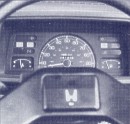 Large speedo dominates instrument panel
|
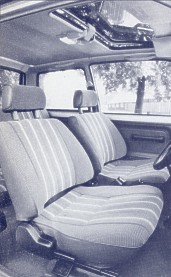 Headroom not as good as it looks and lots of painted metal in cabin
|
|||||||||||||||||||||||||||||||||||||||||||||||||||||||||||||||||||||||||||||||||||||||||||||||||||||||||||||||||||||||||||||||||||||||||||||||||||||||||||||||||||||||||||||||||||||||||||||||||||||||||||||||||||||||||||||||||||||||||||||||||||||||||||||||||||||||||||||||||||||||||||||||||||||||||||||||||||||||||||||||||||||||||||||||||||||||||||||||||||||||||||||||||||||||||||||||||||||||||||||||||||||||||||||||||||||||||||||||||||||||||||||||||||||||
| MOTOR
ROAD TEST No 31/84 Honda Jazz |
||||||||||||||||||||||||||||||||||||||||||||||||||||||||||||||||||||||||||||||||||||||||||||||||||||||||||||||||||||||||||||||||||||||||||||||||||||||||||||||||||||||||||||||||||||||||||||||||||||||||||||||||||||||||||||||||||||||||||||||||||||||||||||||||||||||||||||||||||||||||||||||||||||||||||||||||||||||||||||||||||||||||||||||||||||||||||||||||||||||||||||||||||||||||||||||||||||||||||||||||||||||||||||||||||||||||||||||||||||||||||||||||||||||||
Performance tests
carried out by Motor's
staff at the Motor Industry Research Association
proving ground, Lindley. |
||||||||||||||||||||||||||||||||||||||||||||||||||||||||||||||||||||||||||||||||||||||||||||||||||||||||||||||||||||||||||||||||||||||||||||||||||||||||||||||||||||||||||||||||||||||||||||||||||||||||||||||||||||||||||||||||||||||||||||||||||||||||||||||||||||||||||||||||||||||||||||||||||||||||||||||||||||||||||||||||||||||||||||||||||||||||||||||||||||||||||||||||||||||||||||||||||||||||||||||||||||||||||||||||||||||||||||||||||||||||||||||||||||||||
|
||||||||||||||||||||||||||||||||||||||||||||||||||||||||||||||||||||||||||||||||||||||||||||||||||||||||||||||||||||||||||||||||||||||||||||||||||||||||||||||||||||||||||||||||||||||||||||||||||||||||||||||||||||||||||||||||||||||||||||||||||||||||||||||||||||||||||||||||||||||||||||||||||||||||||||||||||||||||||||||||||||||||||||||||||||||||||||||||||||||||||||||||||||||||||||||||||||||||||||||||||||||||||||||||||||||||||||||||||||||||||||||||||||||||
| Make: Honda. Model: Jazz. Maker: Honda Motor Co. 6-27-8 Chome, Jingumae, Shibuya-ku, Tokyo, Japan. UK Concessionaires: Honda (UK) Ltd, 4 Power Road, Chiswick, London W4 5YT. Tel. 01-995 9381. Price: £ 3,463.55 basic, plus £ 288.62 Car Tax, plus £ 562.83 VAT equals £ 4,315.00 total. | ||||||||||||||||||||||||||||||||||||||||||||||||||||||||||||||||||||||||||||||||||||||||||||||||||||||||||||||||||||||||||||||||||||||||||||||||||||||||||||||||||||||||||||||||||||||||||||||||||||||||||||||||||||||||||||||||||||||||||||||||||||||||||||||||||||||||||||||||||||||||||||||||||||||||||||||||||||||||||||||||||||||||||||||||||||||||||||||||||||||||||||||||||||||||||||||||||||||||||||||||||||||||||||||||||||||||||||||||||||||||||||||||||||||||
| The Rivals Other possible rivals include the Ford Fiesta Popular 1.1 (£ 4,319), Renault 5 GTL (£ 4,520), Suzuki SA 310 GL (£ 3,999), Talbot Samba 1.1 GL (£ 4,395) and Toyota Starlet 1.0 GL (£ 4,267). |
||||||||||||||||||||||||||||||||||||||||||||||||||||||||||||||||||||||||||||||||||||||||||||||||||||||||||||||||||||||||||||||||||||||||||||||||||||||||||||||||||||||||||||||||||||||||||||||||||||||||||||||||||||||||||||||||||||||||||||||||||||||||||||||||||||||||||||||||||||||||||||||||||||||||||||||||||||||||||||||||||||||||||||||||||||||||||||||||||||||||||||||||||||||||||||||||||||||||||||||||||||||||||||||||||||||||||||||||||||||||||||||||||||||||
|
||||||||||||||||||||||||||||||||||||||||||||||||||||||||||||||||||||||||||||||||||||||||||||||||||||||||||||||||||||||||||||||||||||||||||||||||||||||||||||||||||||||||||||||||||||||||||||||||||||||||||||||||||||||||||||||||||||||||||||||||||||||||||||||||||||||||||||||||||||||||||||||||||||||||||||||||||||||||||||||||||||||||||||||||||||||||||||||||||||||||||||||||||||||||||||||||||||||||||||||||||||||||||||||||||||||||||||||||||||||||||||||||||||||||
|
||||||||||||||||||||||||||||||||||||||||||||||||||||||||||||||||||||||||||||||||||||||||||||||||||||||||||||||||||||||||||||||||||||||||||||||||||||||||||||||||||||||||||||||||||||||||||||||||||||||||||||||||||||||||||||||||||||||||||||||||||||||||||||||||||||||||||||||||||||||||||||||||||||||||||||||||||||||||||||||||||||||||||||||||||||||||||||||||||||||||||||||||||||||||||||||||||||||||||||||||||||||||||||||||||||||||||||||||||||||||||||||||||||||||
|
||||||||||||||||||||||||||||||||||||||||||||||||||||||||||||||||||||||||||||||||||||||||||||||||||||||||||||||||||||||||||||||||||||||||||||||||||||||||||||||||||||||||||||||||||||||||||||||||||||||||||||||||||||||||||||||||||||||||||||||||||||||||||||||||||||||||||||||||||||||||||||||||||||||||||||||||||||||||||||||||||||||||||||||||||||||||||||||||||||||||||||||||||||||||||||||||||||||||||||||||||||||||||||||||||||||||||||||||||||||||||||||||||||||||
|
||||||||||||||||||||||||||||||||||||||||||||||||||||||||||||||||||||||||||||||||||||||||||||||||||||||||||||||||||||||||||||||||||||||||||||||||||||||||||||||||||||||||||||||||||||||||||||||||||||||||||||||||||||||||||||||||||||||||||||||||||||||||||||||||||||||||||||||||||||||||||||||||||||||||||||||||||||||||||||||||||||||||||||||||||||||||||||||||||||||||||||||||||||||||||||||||||||||||||||||||||||||||||||||||||||||||||||||||||||||||||||||||||||||||
|
||||||||||||||||||||||||||||||||||||||||||||||||||||||||||||||||||||||||||||||||||||||||||||||||||||||||||||||||||||||||||||||||||||||||||||||||||||||||||||||||||||||||||||||||||||||||||||||||||||||||||||||||||||||||||||||||||||||||||||||||||||||||||||||||||||||||||||||||||||||||||||||||||||||||||||||||||||||||||||||||||||||||||||||||||||||||||||||||||||||||||||||||||||||||||||||||||||||||||||||||||||||||||||||||||||||||||||||||||||||||||||||||||||||||
|
||||||||||||||||||||||||||||||||||||||||||||||||||||||||||||||||||||||||||||||||||||||||||||||||||||||||||||||||||||||||||||||||||||||||||||||||||||||||||||||||||||||||||||||||||||||||||||||||||||||||||||||||||||||||||||||||||||||||||||||||||||||||||||||||||||||||||||||||||||||||||||||||||||||||||||||||||||||||||||||||||||||||||||||||||||||||||||||||||||||||||||||||||||||||||||||||||||||||||||||||||||||||||||||||||||||||||||||||||||||||||||||||||||||||
